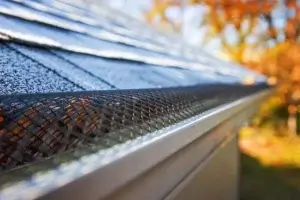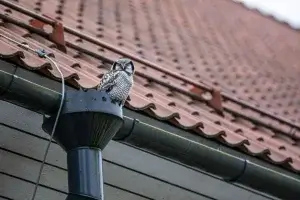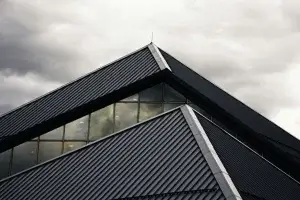At Maupin Roofing, we know the solutions to the most common home exterior problems in Oklahoma City. Here, we share our professional tips to help you not just improve your home’s curb appeal, but also reinforce your property’s structural integrity.
Let’s start!

Constant exposure to direct sunlight, high humidity, and severe weather can compromise the appearance of your home’s exterior paint over the years. The sun beats down on your home’s siding and trim, causing paint to fade, bubble, or peel. Add in moisture from spring rains or humid days, and you’ve got the perfect recipe for blistering paint and exposed surfaces.
This is something worth paying attention to since the exterior painting of your house is just as important as an interior paint job, if not more, especially when considering your home’s curb appeal.
What to Look For
Chalky residue when you rub your hand on the wall
Cracking or curling paint
Bare spots or uneven fading on the siding
What to Do
Scrape off any old paint that has come loose and clean the dirty surface (consider power washing). Painting a wet surface gives you poor adhesion, so make sure the surface is completely dry before starting the paint job. We also recommend using an exterior primer before applying the new paint.
Go with paint that has UV resistance and is built for extreme temperatures, followed by a paint film for more protection. Many homeowners in OKC use acrylic paint, latex paint, or oil-based paint.
2. Wood Trim That’s Rotted or Soft

Trim boards may seem purely decorative, but they actually serve an important purpose: sealing off joints, corners, and transitions where moisture intrusion can happen. But wood trim absorbs water like a sponge when it’s not sealed properly, and all that moisture can lead to dry rot, musty odors, soft spots, and pest infestations.
What to Look for
Dark stains around corners
Warped or squishy boards
Trim that crumbles when you press on it with a screwdriver
What to Do
Cut out any sections of rotted wood and replace them with pressure-treated lumber or PVC trim. If you prefer using actual healthy wood, use a wood hardener on minor soft spots, then repaint or seal the boards with exterior-grade paint or caulk. Then, of course, don’t forget to reseal the corners and end joints!
3. Siding That’s Warped, Cracked, or Falling Off

Strong wind, flying debris, and temperature swings can leave you with damaged siding or siding that warps or pulls away from the house. Wood siding might be split or absorb moisture, leading to bigger structural issues that will require siding replacement.
What to Look for
Loose panels
Visible cracks
Water stains
Insect damage
Warped boards
What to Do
Re-secure any loose pieces right away. For cracked or warped sections, you’ll want to replace the affected panels. If your siding is older and failing in multiple places, it may be time to consider a full replacement using a more durable material. Vinyl siding and fiber cement siding, for example, are top choices for durability.
4. Foundation and Drainage Issues

Oklahoma City’s clay-heavy soil expands and contracts depending on how much rain or drought you’ve had. That constant movement can put a serious strain on your home’s foundation, and without proper drainage, water collects around your home and leads to further damage. These cases need immediate attention.
What to Look for
Hairline cracks in the foundation
Gaps around windows or doors
Uneven floors
Pooling water near the base of your house
What to Do
Keep your gutters and downspouts in good working order (we’ll talk more about this below). Make sure water is being diverted at least 4-6 feet away from the foundation to prevent issues like water intrusion and mold growth. If you’re seeing large cracks or signs of sinking, don’t ignore them. Call a professional to assess your foundation before things get worse.
5. Clogged or Sagging Gutters and Downspouts

Gutters and downspouts tend to get overlooked often, but neglecting them can actually lead to a number of issues, especially during harsh weather. Specifically, clogged gutters force rainwater to back up under your shingles, eroding your foundation and flooding your landscaping.
What to Look for
Overflowing water during rain
Gutters leaning away from the roofline
Plants growing in your gutters
Water stains on the siding below the gutter line
What to Do
Clean your gutters and downspouts twice a year, more if you’ve got a lot of trees nearby. Check for sagging sections and add gutter brackets if needed. Also, make sure your downspouts are actually sending water away from your house. You can add downspout extensions if necessary.
If your gutter system is beyond repair, contact Maupin Roofing for professional gutter installation and replacement services in Oklahoma City and surrounding areas.
6. Roof Damage, Leaks, and Flashing Issues

The usual causes of roof leaks are missing flashing, damaged shingles, or underlayment that’s no longer doing its job. If the leak isn’t identified and addressed as soon as possible, it will allow moisture into your home and could potentially lead to minor or even structural damage.
What to Look for
Water stains on the ceiling
Damp attic insulation
Sagging roof decking
Visible damage to flashing around chimneys, vents, and valleys
What to Do
Get your roof checked at least once a year, or at least after every big storm. If your flashing is loose or damaged, it can usually be replaced without redoing the whole roof. But if the damage is widespread or your roof is more than 15-20 years old, a full inspection (and maybe even a replacement) might be worth looking into.
Maupin Roofing can help you with roof inspection and maintenance services year-round.
7. Poor Insulation

Poor insulation isn’t always visible, but it definitely makes itself known—like when you suddenly have higher energy bills in the summer or winter. Bad insulation means air leaks through small cracks in your home in places that don’t have proper sealing, making it hard for your household to truly be energy efficient.
What to Look for
High electricity bills
Rooms that are hard to heat or cool
Drafty walls or ceilings
HVAC system never seems to stop running
What to Do
Start with the attic. If you don’t have at least 10-14 inches of insulation up there, it’s time to add more. Sealing air leaks around vents, pipes, attic hatches, and light fixtures also helps reduce energy loss. Bonus: good insulation also helps reduce noise and keeps your roof healthier by reducing condensation in winter.
8. Cracked Concrete in Driveways or Walkways

The freeze-thaw cycle in Oklahoma plays rough with concrete. The sudden temperature swings can leave cracks in sidewalks, patios, and driveways.
What to Look for
Hairline cracks
Trip hazards
Uneven slabs
Areas where water pools
What to Do
Fill small cracks with a concrete caulk or sealant before they widen. Larger damage might need professional repair or resurfacing. Also, don’t underestimate the benefit of sealing your concrete—it helps block out water and slow down the damage as time passes. It also improves the appearance of your home’s exterior.
9. Poor Attic Ventilation

An overheated attic shortens the life of your shingles and raises the temperature in your whole house. Additionally, if you don’t ensure proper ventilation during winter, it may lead to condensation and even mold growth.
What to Look for
Extremely hot attic air
Visible moisture or mildew
Curling shingles
Ice dams in the winter
What to Do
Make sure your attic has a balanced ventilation system. That means intake vents along the eaves and exhaust vents near the roof peak. Ridge vents combined with soffit vents work great. This keeps air moving and reduces both heat and moisture buildup.
10. Pest Entry Points

Sometimes your biggest enemy isn’t the weather—it’s a family of squirrels in the attic, or other pests making a home in your siding. In reality, these unwelcome guests aren’t just a nuisance. They can lead to issues and costly repairs over time.
What to Look for
Chewed-up soffits
Holes in siding
Scratching sounds in the walls (especially at night)
What to Do
Seal up entry points around the vents, pipes, and gaps in trim or siding. Check these repaired areas regularly to make sure they stay sealed. Make sure soffits and roof vents have screens. Also, trim back tree limbs that touch the house to keep critters from jumping onto your roof.
Need Professional Help? Contact Maupin Roofing!
At Maupin Roofing, we provide exterior services to OKC and surrounding areas. You can schedule a service with us for regular inspections, or if you need solutions to common exterior issues promptly. We always follow the most effective methods and use the right materials, whether it’s to fix minor damage or do something more complicated.
Reach out today for a free estimate!

Solar Roofs for Residential Properties: Harnessing Modern Energy
In the past decade or so, solar roofs for residential properties have become popular. Maupin Roofing stays up to date with all things roofing, and

Gutters and Downspouts Prevent Ice Dams and Roof Leaks
Winter in Oklahoma can throw just about everything at your roof—freezing rain, heavy snow, and those sneaky ice dams that creep up when you least

Downspout Placement and Roof Drainage: Top 15 Best Practices
How important is downspout placement and roof drainage in preventing water damage? At Maupin Roofing, we like to say: it’s not just about keeping water

Top 10 Commercial Metal Roofing Benefits in Oklahoma City
With modern designs, better coatings, and smarter installation techniques, metal roofs have become a top option for businesses. Maupin Roofing shares the top 10 commercial

Metal Roofs for Homes: Top Choices for Oklahoma City
Considering an upgrade and wondering about metal roofs for homes? Maupin Roofing is here to discuss everything you need to know—from the different types of

How to Spot Roof Damage After a Storm: A Quick Guide
Need tips on how to spot roof damage after a storm? Maupin Roofing has the answers! Below, we’ve put together an after-storm roof inspection checklist








